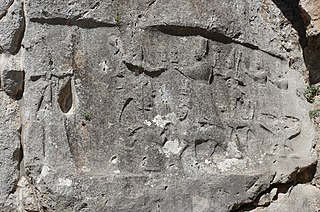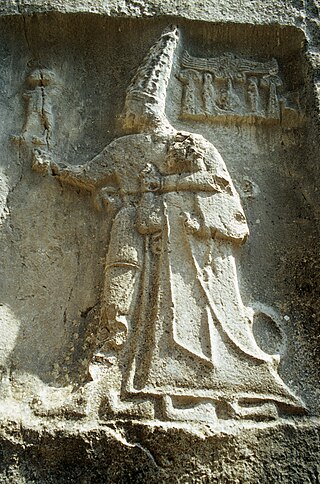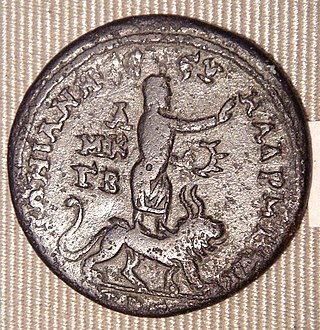
Teshub was the Hurrian weather god, as well as the head of the Hurrian pantheon. The etymology of his name is uncertain, though it is agreed it can be classified as linguistically Hurrian. Both phonetic and logographic writings are attested. As a deity associated with the weather, Teshub could be portrayed both as destructive and protective. Individual weather phenomena, including winds, lightning, thunder and rain, could be described as his weapons. He was also believed to enable the growth of vegetation and create rivers and springs. His high position in Hurrian religion reflected the widespread importance of weather gods in northern Mesopotamia and nearby areas, where in contrast with the south agriculture relied primarily on rainfall rather than irrigation. It was believed that his authority extended to both mortal and other gods, both on earth and in heaven. However, the sea and the underworld were not under his control. Depictions of Teshub are rare, though it is agreed he was typically portrayed as an armed, bearded figure, sometimes holding a bundle of lightning. One such example is known from Yazılıkaya. In some cases, he was depicted driving in a chariot drawn by two sacred bulls.

Šarruma, also romanized as Šarrumma or Sharruma, was a Hurrian god. He could be depicted in both anthropomorphic form, sometimes riding on the back of a leopard, and in the theriomorphic form as a bull. His character is not fully understood, though it is known that he could function as a mountain god. He was regarded as a son of Ḫepat and Teshub. He was also linked to various moon deities. Additionally, the only mythological text he appears in addresses him as a messenger (sukkalu) of Kumarbi. He was worshiped by Hurrians in southeastern Anatolia and northern Syria, for example in Kummanni and Lawazantiya in Kizzuwatna. From this kingdom he was introduced to the Hittite pantheon as well. Hittite influence in turn resulted in his introduction to cities such as Aleppo, Emar and Ugarit. He was also venerated in Luwian religion in the first millennium BCE, with theophoric names invoking him attested from as late as the Hellenistic period in Cilicia and Lycia.

Ḫepat was a goddess associated with Aleppo, originally worshiped in the north of modern Syria in the third millennium BCE. Her name is often presumed to be either a feminine nisba referring to her connection to this city, or alternatively a derivative of the root ḫbb, "to love". Her best attested role is that of the spouse of various weather gods. She was already associated with Adad in Ebla and Aleppo in the third millennium BCE, and in later times they are attested as a couple in cities such as Alalakh and Emar. In Hurrian religion she instead came to be linked with Teshub, which in the first millennium BCE led to the development of a tradition in which she was the spouse of his Luwian counterpart Tarḫunz. Associations between her and numerous other deities are described in Hurrian ritual texts, where she heads her own kaluti, a type of offering lists dedicated to the circle of a specific deity. She commonly appears in them alongside her children, Šarruma, Allanzu and Kunzišalli. Her divine attendant was the goddess Takitu. In Hittite sources, she could sometimes be recognized as the counterpart of the Sun goddess of Arinna, though their respective roles were distinct and most likely this theological conception only had limited recognition. In Ugarit the local goddess Pidray could be considered analogous to her instead.
Kumarbi, also known as Kumurwe, Kumarwi and Kumarma, was a Hurrian god. He held a senior position in the Hurrian pantheon, and was described as the "father of gods". He was portrayed as an old, deposed king of the gods, though this most likely did not reflect factual loss of the position of the head of the pantheon in Hurrian religion, but only a mythological narrative. It is often assumed that he was an agricultural deity, though this view is not universally accepted and the evidence is limited. He was also associated with prosperity. It was believed that he resided in the underworld.
Ḫašamili was a god worshiped in Bronze Age Anatolia. He originated in religious beliefs of the Hattians, and later came to be incorporated into the Hittite, Palaic and Luwian pantheons. He was regarded as a protective household deity, and was additionally associated with metalworking. He appears in the myth of Ḫaḫḫima, but his role in it is not fully understood.

Nikkal or Nikkal-wa-Ib was a goddess worshiped in various areas of the ancient Near East west of Mesopotamia. She was derived from the Mesopotamian goddess Ningal, and like her forerunner was regarded as the spouse of a moon god, whose precise identity varied between locations. While well attested in Hurrian and Hittite sources, as well as in Ugarit, she is largely absent from documents from the western part of ancient Syria.
Manuzi was a mountain god worshiped in Kizzuwatna. He shared his name with the mountain he represented and with a village. He is best attested from sources pertaining to the hišuwa festival, which indicate he was the husband of the goddess Lelluri. He could be identified as a form of the Hurrian weather god Teshub as well, and as such was referred to as Teshub Manuzi.

Šanta (Santa) was a god worshiped in Bronze Age Anatolia by Luwians and Hittites. It is presumed that he was regarded as a warlike deity, and that he could additionally be associated with plagues and possibly with the underworld, though the latter proposal is not universally accepted. In known texts he frequently appears alongside Iyarri, a deity of similar character. He is first attested in documents from Kanesh dated to the Old Assyrian period, and continues to appear in later treaties, ritual texts and theophoric names. He is also present in an offering lists from Emar written in Akkadian, though he did not belong to the local pantheon and rituals involving him were only performed on behalf of the Hittite administration by local inhabitants.
Ḫapantali, also known as Ḫapantaliya, was a Luwian goddess who functioned as a divine shepherd. She was also incorporated into Hattian and Hittite beliefs. She is first attested in the Old Assyrian period, and later continued to be worshiped until the fall of the Hittite Empire. She appears in a variety of texts, including descriptions of festivals, treaties, and myths. While in ritual texts she was often linked with Inar, in mythological context she instead could be designated as a helper of Kamrušepa or her husband Tiwad.
Šuwaliyat was a Hittite god associated with vegetation. He was worshiped in Kanesh, Ḫupišna and Ḫunḫuišna, as well as in Hattusa. In a number of ritual texts he appears alongside the grain goddess Ḫalki. A close connection between him and the Hurrian god Tašmišu is also attested, and in Hittite adaptations of Hurrian myths and in other texts reflecting Hurrian influence his name could be used to designate his Hurrian counterpart.

The Hurrian religion was the polytheistic religion of the Hurrians, a Bronze Age people of the Near East who chiefly inhabited the north of the Fertile Crescent. While the oldest evidence goes back to the third millennium BCE, it is best attested in cuneiform sources from the second millennium BCE written not only in the Hurrian language, but also Akkadian, Hittite and Ugaritic. It was shaped by the contacts between Hurrians and various cultures they coexisted with. As a result, the Hurrian pantheon included both natively Hurrian deities and those of foreign origin, adopted from Mesopotamian, Syrian, Anatolian and Elamite beliefs. The culture of the Hurrians was not entirely homogeneous, and different local religious traditions are documented in sources from Hurrian kingdoms such as Arrapha, Kizzuwatna and Mitanni, as well as from cities with sizeable Hurrian populations, such as Ugarit and Alalakh.

Tarḫunna or Tarḫuna/i was the Hittite weather god. He was also referred to as the "Weather god of Heaven" or the "Lord of the Land of Hatti".
Maliya was a goddess worshiped by Hittites in the Bronze Age. She was most likely a deified river in origin, but she was also associated with gardens and with artisanship, specifically with leatherworking and carpentry. The oldest attestations of her have been identified in the Old Assyrian texts from Kanesh. This city continued to be associated with her in later tradition, though she was also worshiped in Hattusa and elsewhere in the Hittite Empire. She is also present in texts originating in Kizzuwatna, which indicate she had a temple in Kummanni, where she was worshiped alongside various Hurrian deities.

Šimige was the Hurrian sun god. Known sources do not associate him with any specific location, but he is attested in documents from various settlements inhabited by the Hurrians, from Kizzuwatnean cities in modern Turkey, through Ugarit, Alalakh and Mari in Syria, to Nuzi, in antiquity a part of the kingdom of Arrapha in northeastern Iraq. His character was to a large degree based on his Mesopotamian counterpart Shamash, though they were not identical. Šimige was in turn an influence on the Hittite Sun god of Heaven and Luwian Tiwaz.

Ninatta and Kulitta were a dyad of Hurrian goddesses regarded as the handmaidens of Šauška. They were primarily considered divine musicians, though they also had a warlike aspect. They are attested in western Hurrian sources from Ugarit and Hattusa. They were also incorporated into the Hittite and Mesopotamian pantheons.
Takitu, Takiti or Daqitu was a Hurrian goddess who served as the sukkal of Ḫepat. She appears alongside her mistress in a number of Hurrian myths, in which she is portrayed as her closest confidante. Her name is usually assumed to have its origin in a Semitic language, though a possible Hurrian etymology has also been proposed. She was worshiped in Hattusa, Lawazantiya and Ugarit.
Tašmišu (Tashmishu) was a Hurrian god. He was regarded as a brother of Teshub, and it is assumed he had a warlike character.
Karhuha (Karḫuḫa), also known as Karḫuḫi, was the tutelary god of the ancient city of Carchemish. He was associated with deer, and it is presumed his character was similar to that of Hittite Kurunta. He is first attested in texts from the second half of the second millennium BCE, and there is no agreement among researchers if he was a Hurrian god in origin or if similarly to closely associated goddess Kubaba he predated Hurrian control over the region. He appears in a variety of Hittite and Luwian texts, and continued to be worshiped through the first millennium BCE.
Taru was a weather god worshiped in ancient Anatolia by Hattians. He was associated with the bull, and could be depicted in the form of this animal. It is presumed that the names of the Hittite and Luwian weather gods, Tarḫunna and Tarḫunz, while etymologically Indo-European, were meant to resemble Taru's as a result of Hattian cultural influence on other cultures of the region.
Tenu was a Hurrian god regarded as a divine attendant (sukkal) of Teshub. He might have originated in a local tradition typical for Aleppo. He appears in a number of Hurrian offering lists (kaluti), as well as Hittite and Emariote texts.









